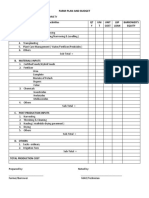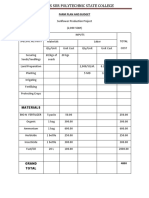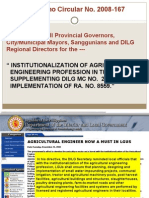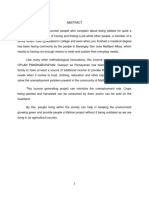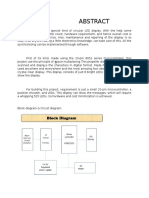Professional Documents
Culture Documents
Good Practices in Agro-Enterprise Clustering Approach (AECA)
Good Practices in Agro-Enterprise Clustering Approach (AECA)
Uploaded by
Caryl Dorothy TanOriginal Description:
Copyright
Available Formats
Share this document
Did you find this document useful?
Is this content inappropriate?
Report this DocumentCopyright:
Available Formats
Good Practices in Agro-Enterprise Clustering Approach (AECA)
Good Practices in Agro-Enterprise Clustering Approach (AECA)
Uploaded by
Caryl Dorothy TanCopyright:
Available Formats
Good Practices in Agro-enterprise Clustering
Approach (AECA)
The clustering approach is envisioned to be a farmers’ journey of learning. It is a sequence of
eight (8) steps that a lead or support institution can be used as a guide as the farmers go
through for group learning and action in farming as a business and in collective marketing.
Each step in the AECA specifies the activities facilitated by a dedicated extension agent or field
staff from a lead institution that works directly with the farmers. The process is sequential so
that results of each step constitute the starting point for the succeeding steps.
To make simple complex ideas in business, AECA is presented as a journey of learning with a
vehicle (bus) on the road carrying the extension agent (or field facilitator) with the organized
farmers through three phases that includes altogether eight steps. (Figure 1)
The first six steps are organizing and preparation. The actual group marketing takes place in
Step 7, starting with test marketing in Step 7 and developed into an ongoing and growing
marketing enterprise in Step 8 through regular evaluation and improvement.
Good Practices in Agro-enterprise Clustering Approach
Page 1 of 9
Good Practices in Agro-enterprise Clustering
Approach (AECA)
Step 1: Formation of Working Group and Basic Cluster
Key Elements:
-Formation of Working Group
-Formation of Clusters with profile
-Identification of Cluster Officers
-Quick Site Appraisal
-Formation of Two (2) Study Teams
Major Activities:
-Identification, orientation and securing commitment of stakeholders
-Formation and profiling of at least 2 initial clusters (10-15 members per cluster)
-Identification of cluster officers: cluster leader, production coordinator, postharvest coordinator,
secretary, food safety officer
-Site appraisal of the farmers and the farming community
-Formation of study teams: Supply Study Team and Market Study Team
Good Practices:
• The head of the lead institution’s presence during initial activities in gathering support from
other stakeholders will reflect the institutions commitment to the implementation of AECA.
• Maintain regular communication to the members of the working group by setting regular
meetings.
• Head of working group members provide support to AECA implementation by assigning a staff
to help the facilitator from the lead institution.
• The lead institution can organize clusters within a formal farmer organization (informal clusters
within a cooperative or an association).
• Be clear during the orientation with the farmers that this process will require their active
participation, that this will be their journey and the working group will be their support in
implementing the process.
• Focus on few clusters at the start. Inviting farmers who have demonstrated leadership or
entrepreneurial behavior will help in convincing other farmers to join the cluster.
• Encourage farmers, who are known in the area to have good production practice and high yield
of initially identified crop, to be part of the supply study team. For the market study team,
encourage farmers with experience in selling their products to 2 or more markets.
Good Practices in Agro-enterprise Clustering Approach
Page 2 of 9
Good Practices in Agro-enterprise Clustering
Approach (AECA)
Step 2: Creation of Production Module and Cluster Supply Plan
Key Elements:
-Selection of Product
-Creation of Production Module (recommended farming practice and production cost)
-Creation of Initial Cluster Supply Plan
Major Activities:
-Discussion and agreement of priority product for collective marketing
-Gathering of information on production practices with cost and profit by the Supply Study Team
-Discussion on initial cluster supply plan of product agreed by the farmers
-Approval and adoption of the production module and supply plan
Good Practices:
• Assigned field facilitators to get the consensus of the farmers on both the production module
and supply plan. The facilitator’s role is to facilitate the discussion and not to decide for the
farmers.
• Guide the farmers in assessing both the opportunity and the risks if a new product is selected
and let the farmers decide if they want to pursue the new product. It is very important that the
farmers have an ownership of the decision.
• Recommended farming practice can be based on the successful farmers’ practices.
• Conduct trial production/field demonstration if there are new farming practice identified in the
recommended practice. Involve the farmers in the trial production by doing the trial near the
farmers.
• Provide hands-on guidance and repeated explanations in teaching cost and income
computation in the production module. Regular visits and learning sessions with the farmers
will help deepen the relationship between the field facilitator and the farmers.
• For the cluster supply plan, allow a certain percentage of the farmer’s harvest to be committed
for collective marketing. This is to ensure that the factor of uncertainty in supply, when farmers
must pay loans to traders, or when adverse weather damaged the crop, and among other
reasons, are accounted for.
• Local study team and cluster secretary should record all agreements during the meeting.
Good Practices in Agro-enterprise Clustering Approach
Page 3 of 9
Good Practices in Agro-enterprise Clustering
Approach (AECA)
Step 3: Development of an Agro-enterprise (AE) Objective
Key Elements:
-Market Information Gathering
-Analysis of Market Information Gathered
-Developing Market Projections and AE Objective
Major Activities:
-Market chain mapping
-Market chain study (market visits and interviews) and price monitoring by the Market Study Team
-Consolidation of information gathered, comparison and analysis of the market that were interviewed
-Selection of target market and value chain mapping
-Presentation of the AE Objective to the officers and the members
Good Practices:
• Ensure the involvement of the farmers during the market chain study and analysis of the
information gathered.
• Present the result of the market chain study in a simple and easy to understand manner.
• Help the farmers in analyzing and starting with the low risk market first to be able to focus and
build the skills and confidence in collective marketing.
• Prioritize friendly institutional buyers aside from the traders as a market.
• During the value chain mapping, include all possible marketing costs and analyze possible
combination of markets in order for the delivery to be viable.
• Information on price should always be available and accessible to farmers. The group can find
someone from the local market to help them provide price information or they can tap their
LGU for help.
Good Practices in Agro-enterprise Clustering Approach
Page 4 of 9
Good Practices in Agro-enterprise Clustering
Approach (AECA)
Step 4: Formalization of Committed Clusters
Key Elements:
-Approval of AE Objective
-Signing of initial cluster supply plan
-Writing policies and agreements
Major Activities:
-Analysis and approval of the AE Objective
-Discussion and signing of committed members on the cluster supply plan
-Drafting of initial policies and agreements related to production and collective marketing
-Presentation of initial policies to the members
Good Practices:
• Gather consensus with the farmers on their group’s AE objective and emphasize that the
objective is based on their analysis and not being imposed by the lead institution.
• It is possible that the number of farmers will be reduced at this stage of the process. Focus on
those who are really active and encourage them more by acknowledging their help/work.
• During the writing of policies and agreements, provide possible scenarios to the farmers that
will help them craft the policies and agreements.
• Provide all members a copy of the written policies and agreements and have them sign it to
signify their commitment to follow the group’s policies and agreements.
Good Practices in Agro-enterprise Clustering Approach
Page 5 of 9
Good Practices in Agro-enterprise Clustering
Approach (AECA)
Step 5: Finalization of Agro-enterprise (AE) Plan
Key Element:
-Approved AE Plan
Major Activities:
-Drafting of the AE Plan by the study teams and cluster officers
-Presentation of the AE Plan to the members
-Approval of the AE Plan
Good Practices:
• During the drafting of the AE Plan, it’s important for the farmers to understand where the
information on the AE Plan will be coming from. The field facilitator should bear in mind that
the farmer members of the study team as well as the cluster officers should be able to present
this to the other members of the group.
• Coaching the farmers before the presentation to the other farmer members will give them
more confidence and ownership of the AE Plan.
• The AE plan should also be presented to the working group to be able for the farmers to secure
the commitment to support their plan.
• Upon approval of the AE Plan, the cluster secretary should keep the agreements and the plan
itself since this will also be the basis during the assessment to be made in Step 8.
Good Practices in Agro-enterprise Clustering Approach
Page 6 of 9
Good Practices in Agro-enterprise Clustering
Approach (AECA)
Step 6: Creation of Supply Forecast
Key Elements:
-Field monitoring
-Updating of cluster supply plan
-Reporting of supply forecast
Major Activities:
-Regular field monitoring of the field facilitator and the production coordinator
-Interview with cluster members to update the supply plan
-Cluster supply plan updating by the production coordinator and field facilitator
-Presentation of the supply forecast to officers and working group
Good Practices:
• During the field monitoring, it is important to note the factors that might affect the target
supply of the cluster. These factors should be considered during the next planting cycle and be
ready with solutions.
• During the analysis and updating of the cluster supply plan, if there are cluster members that
cannot meet their committed volume, the members may decide to secure volume from other
members who have surplus volume. But this should be agreed by all members and should be
included in the written policies and agreements.
• Communicate regularly with the market on the supply forecast. If based on the forecast the
farmers cannot fulfill the order, it is best to inform the buyer/market to be able for them to find
alternative supplier for the unfulfilled volume.
• The group can also assign the cluster leader to help the production coordinator in the field
monitoring and interview with the members.
Good Practices in Agro-enterprise Clustering Approach
Page 7 of 9
Good Practices in Agro-enterprise Clustering
Approach (AECA)
Step 7: Validation of Agro-enterprise (AE) Plan through Test Delivery
Key Elements:
-Preparation for Test Delivery
-Actual Test Delivery
Major Activities:
-Secure all delivery requirements of the buyer
-Secure all packaging and logistics requirements
-Consolidation and quality assurance of the product by the postharvest coordinator and cluster officers
-Actual delivery to the market
Good Practices:
• Confirm the delivery date, volume and requirements to the buyer/market at least 3 days before
the delivery date. This is to ensure that all information on the delivery details is correct.
• Be ready with buffer supply if in case the target volume was not met during
consolidation/quality check.
• Secure quality specifications from the buyer/market to ensure non-rejection of products upon
arrival to the delivery point.
• Encourage the farmers to participate in the delivery to better appreciate the process and
deepen their understanding on the importance of their delivery to the market.
• If there are unexpected incidents during actual delivery that may affect the time of arrival in the
drop off point, communicate immediately with the buyer and explain the reason of the delay.
Good Practices in Agro-enterprise Clustering Approach
Page 8 of 9
Good Practices in Agro-enterprise Clustering
Approach (AECA)
Step 8: Evaluation and Improvement of Agro-enterprise (AE) Plan
Key Elements:
-Test delivery reporting and assessment
-Adjustment/revision of the AE Plan
Major Activities:
-Reporting of the actual delivery to the members and working group
-Assessment of the test delivery based on the AE Plan
-Revision of the AE Plan based on the actual experience
Good Practices:
• Allow the farmers who joined the delivery to share the experience.
• During assessment, point out the major deviation between the plan and the actual experience.
This will help the farmers analyze what needs to be improve in the next delivery.
• Gather consensus from the members on the decision to continue their chosen market and help
them by comparing the pros and cons based on the experience and revised AE Plan.
Good Practices in Agro-enterprise Clustering Approach
Page 9 of 9
You might also like
- LRP - Intro. To Agri. Commodity & Enterprise Dev. - AGEC02Document76 pagesLRP - Intro. To Agri. Commodity & Enterprise Dev. - AGEC02Gesabel Impabido100% (2)
- Kuppelwieser - 2020Document10 pagesKuppelwieser - 2020ginta_rock9No ratings yet
- Project AniwagDocument207 pagesProject Aniwagsnsdean67% (3)
- Letter of Application Template: Subject: Application For Grant Assistance Under Enhanced Kadiwa ProgramDocument13 pagesLetter of Application Template: Subject: Application For Grant Assistance Under Enhanced Kadiwa ProgramRizza Mae BuracNo ratings yet
- Overview of Palay CheckDocument38 pagesOverview of Palay CheckFroy100% (1)
- PalayCheck System - 2020 Final Revised EditionDocument108 pagesPalayCheck System - 2020 Final Revised EditionLinchoco Rice Dealer100% (4)
- Sample FARM PLAN AND BUDGET - DennisDocument1 pageSample FARM PLAN AND BUDGET - Dennisl.a. lopez100% (2)
- TUPAD Overview1Document21 pagesTUPAD Overview1Jaidan Jude MatulacNo ratings yet
- Commodity System Analysis of Rice Production in BaaoDocument23 pagesCommodity System Analysis of Rice Production in BaaoAndie Bibares83% (6)
- LanzonesDocument29 pagesLanzonesrichardmaravillas100% (6)
- Feasibility Draft of Yellow Corn in Salug Valley (3-18-19)Document30 pagesFeasibility Draft of Yellow Corn in Salug Valley (3-18-19)Joseph Hachero Timbancaya100% (4)
- Farm Plan and BudgetDocument8 pagesFarm Plan and BudgetMaria Angela Somera Naval0% (1)
- Upland Rice Seed Production Project ProposalDocument3 pagesUpland Rice Seed Production Project Proposaljoeeeee100% (2)
- The Clustering Approach To Agroenterprise Development - 2aDocument84 pagesThe Clustering Approach To Agroenterprise Development - 2alani_concepcionNo ratings yet
- Module 1 Concepts of Extension Approach - Dr. Eulene Pizana 1Document18 pagesModule 1 Concepts of Extension Approach - Dr. Eulene Pizana 1Ardniel A. Baladjay0% (1)
- Rice Techno Demo ProposalDocument8 pagesRice Techno Demo ProposalMarlon Manaya Garrigues100% (1)
- GFRAS NELK M11-Agricultural Entrepreneurship-ManualDocument273 pagesGFRAS NELK M11-Agricultural Entrepreneurship-ManualNikk G100% (1)
- AG EXT Chapter10Document11 pagesAG EXT Chapter10Oliver Talip67% (3)
- 2018 Lanao Del Norte Rice ProductionDocument55 pages2018 Lanao Del Norte Rice ProductionAgriculture Lanao del NorteNo ratings yet
- Post-Harvest Technologies of Corn: Pampanga State Agricultural UniversityDocument51 pagesPost-Harvest Technologies of Corn: Pampanga State Agricultural UniversityLoreen100% (1)
- AGRI 6 MODULE 3 Version 3bDocument20 pagesAGRI 6 MODULE 3 Version 3bGlenda Sofia VeaNo ratings yet
- Governor Miguel Luis: Villafuerte JRDocument1 pageGovernor Miguel Luis: Villafuerte JRBlezel Mae AlzagaNo ratings yet
- Pointers On Applying Flower Inducer To Mango TreesDocument13 pagesPointers On Applying Flower Inducer To Mango TreesValjohn Paul Quintans100% (4)
- Mango Production and ManagementDocument13 pagesMango Production and ManagementFranklin Cruz LechugasNo ratings yet
- My Technoguide For Ampalaya Production Part 1Document39 pagesMy Technoguide For Ampalaya Production Part 1haroldlacaba67% (3)
- Abaca Plantation Proposal PenacioDocument3 pagesAbaca Plantation Proposal PenacioMILLER J. VILLAS100% (3)
- Training On Organic AgricultureDocument3 pagesTraining On Organic AgricultureAgriculture100% (2)
- Rice & Corn Milling Operation-ShiolanDocument11 pagesRice & Corn Milling Operation-Shiolanenteng noay100% (1)
- Corn RationaleDocument1 pageCorn RationaleJoshua De Leon100% (1)
- Pro Forma Letter of IntentDocument1 pagePro Forma Letter of IntentBilly E MagtanongNo ratings yet
- Chinese CabbageDocument7 pagesChinese Cabbagesuhaanarora50% (2)
- Corn Production Demonstration FarmDocument12 pagesCorn Production Demonstration FarmALLAN SANORIANo ratings yet
- IPCR of The Office of The Municipal AgriculturistDocument21 pagesIPCR of The Office of The Municipal AgriculturistOren Estabillo Mendoza100% (1)
- Training Proposal - Organic FarmingDocument2 pagesTraining Proposal - Organic Farmingroberto100% (2)
- SANGLAY - RCEF - Case Study Proposal-InHouse 2021Document7 pagesSANGLAY - RCEF - Case Study Proposal-InHouse 2021Charmyne De Vera SanglayNo ratings yet
- Bayanihan Sa AGRIKULTURA:: Farm and Fisheries Clustering and Consolidation Program (F2C2)Document8 pagesBayanihan Sa AGRIKULTURA:: Farm and Fisheries Clustering and Consolidation Program (F2C2)Kurt GayondatoNo ratings yet
- RSBSA Enrollment Form 1 PDFDocument1 pageRSBSA Enrollment Form 1 PDFRonalene Garbin100% (3)
- Crop Yield (Metric Tons Per Hectare) Total Production Area HarvestedDocument3 pagesCrop Yield (Metric Tons Per Hectare) Total Production Area HarvestedRonz Rogan50% (2)
- Abaca Common Pest and DiseasesDocument25 pagesAbaca Common Pest and Diseasesfrances tabuyogNo ratings yet
- DILG MC No. 2008-167Document15 pagesDILG MC No. 2008-167jaypeneyra100% (2)
- Introduction Jaymie BaralDocument10 pagesIntroduction Jaymie Barallea leaNo ratings yet
- Project Briefs in Shrimp Paste - DTI Region 12Document6 pagesProject Briefs in Shrimp Paste - DTI Region 12Nap MissionnaireNo ratings yet
- A Case Study of Luntian Multi-Purpose Cooperative PDFDocument8 pagesA Case Study of Luntian Multi-Purpose Cooperative PDFNaruto UzumakiNo ratings yet
- Project Proposal-West Timawa PO With Complete AnnexesDocument29 pagesProject Proposal-West Timawa PO With Complete AnnexesStewart Paul TorreNo ratings yet
- Agricultural Extension and CommunicationDocument58 pagesAgricultural Extension and CommunicationMesheil TaladroNo ratings yet
- Key Check 8 Harvest ManagementDocument17 pagesKey Check 8 Harvest Managementjames reid100% (1)
- Economic SurveyDocument6 pagesEconomic SurveyMar GarciaNo ratings yet
- SSFA Coco Syrup BP Draft 09.5.2016Document66 pagesSSFA Coco Syrup BP Draft 09.5.2016Derwin DomiderNo ratings yet
- CPT 125: Farming Systems: Kim John R. NateDocument10 pagesCPT 125: Farming Systems: Kim John R. NateKim John NateNo ratings yet
- Exposure Trip Guide RationaleDocument8 pagesExposure Trip Guide RationaleMaria Sushmita de Leon100% (1)
- Nursery EstablishmentDocument22 pagesNursery Establishmentleolasty78% (32)
- Rice Competitiveness Enhancement FundDocument2 pagesRice Competitiveness Enhancement FundLanie HampacNo ratings yet
- 1 Agricultural ExtensionDocument74 pages1 Agricultural ExtensionShaenna Marato Ali100% (2)
- Letter of Request - Sen - VillarDocument3 pagesLetter of Request - Sen - VillarVeron GarciaNo ratings yet
- A Project Proposal AcpcDocument10 pagesA Project Proposal AcpcAclims MalaNo ratings yet
- Enhanced Kadiwa Grant Assistance Guide FINAL 7.4.20Document33 pagesEnhanced Kadiwa Grant Assistance Guide FINAL 7.4.20Randell Manjarres100% (1)
- SENSORY EVALUATION SCORE SHEET KimchiDocument1 pageSENSORY EVALUATION SCORE SHEET KimchiDenisse A100% (1)
- The Clustering Approach To Agroenterprise Development - 2bDocument52 pagesThe Clustering Approach To Agroenterprise Development - 2blani_concepcionNo ratings yet
- Re Positioning of Extension Department (Power Point)Document38 pagesRe Positioning of Extension Department (Power Point)Rufus Leandre100% (2)
- Channel Management: Key DecisionsDocument17 pagesChannel Management: Key DecisionsMelanie Cruz ConventoNo ratings yet
- Agribusiness Management : Strategies for Successful Farming EnterprisesFrom EverandAgribusiness Management : Strategies for Successful Farming EnterprisesNo ratings yet
- Rekap Data SK CPNS LampungDocument6 pagesRekap Data SK CPNS LampungAbidDermawanNo ratings yet
- Propeller Display AbstractDocument2 pagesPropeller Display AbstractmanishkumarNo ratings yet
- Ijact V2i1p106Document6 pagesIjact V2i1p106Winoth KannanNo ratings yet
- JWagner ResumeDocument2 pagesJWagner ResumeAnkur MidhaNo ratings yet
- Quantitative Research Design and MethodDocument54 pagesQuantitative Research Design and MethodRonald LucasiaNo ratings yet
- SPR 2002Document56 pagesSPR 2002Coq Rouge100% (1)
- XK3119P User ManualDocument8 pagesXK3119P User ManualEugenio Hermosilla100% (2)
- Tam4 SF 1CDocument24 pagesTam4 SF 1Cari_canNo ratings yet
- Group If Statement Excercises Ch3Document5 pagesGroup If Statement Excercises Ch3chunganNo ratings yet
- Harmonic MeanDocument2 pagesHarmonic MeanArsalan HunjraNo ratings yet
- CH 1Document51 pagesCH 1Deep MakadiyaNo ratings yet
- Outdoor Integrated Cabinet ICC710-HA1H-C5 (01075401) Datasheet 03 - (20201031)Document2 pagesOutdoor Integrated Cabinet ICC710-HA1H-C5 (01075401) Datasheet 03 - (20201031)Odai KiwanNo ratings yet
- UNIT I-Part-2Document38 pagesUNIT I-Part-2Suyog JadhavNo ratings yet
- Pythagoras-5 (Solutions)Document6 pagesPythagoras-5 (Solutions)ٍZaahir AliNo ratings yet
- Abs VSC PDFDocument1 pageAbs VSC PDFbengkel QNo ratings yet
- PLANOS STANDARD FRAME 7 - v1Document9 pagesPLANOS STANDARD FRAME 7 - v1Daniel NovarioNo ratings yet
- Model Question Introduction To Mass CommunicationDocument11 pagesModel Question Introduction To Mass CommunicationJazeel75% (8)
- Privacy and EthicsDocument19 pagesPrivacy and Ethicslira todayNo ratings yet
- Service Manual: DCR-TRV255E/TRV260/TRV265/TRV265EDocument135 pagesService Manual: DCR-TRV255E/TRV260/TRV265/TRV265EJuan Carlos MuñozNo ratings yet
- S.No. Partner Name Communication Address State CityDocument9 pagesS.No. Partner Name Communication Address State CityKumar Abhishek100% (1)
- Ars 08390Document11 pagesArs 08390Abdul HannanNo ratings yet
- HardwareScanLog 20221201 120730Document1 pageHardwareScanLog 20221201 120730Rohan Kumar 2020No ratings yet
- Clairity Pro Quick Start GuideDocument2 pagesClairity Pro Quick Start GuideGustavo MArtinezNo ratings yet
- Environmental Science: Module 3 Activity 1 Calculating Philippine Population DensityDocument2 pagesEnvironmental Science: Module 3 Activity 1 Calculating Philippine Population DensityJillian Dela CruzNo ratings yet
- HarmonicMediaGridServer 4.4 ReleaseNotesDocument36 pagesHarmonicMediaGridServer 4.4 ReleaseNotesRobertNo ratings yet
- Alternador Serie1000Document24 pagesAlternador Serie1000Augusto BellezaNo ratings yet
- API-NG Reference Guide - 28th JulyDocument232 pagesAPI-NG Reference Guide - 28th JulyAnonymous 80XHV2IIqNo ratings yet
- Bca New Syllabus 2019Document52 pagesBca New Syllabus 2019Shekhar PalaiNo ratings yet
- Gamasutra - Simon Carless's Blog - We Need To Talk About Steam & ChinaDocument9 pagesGamasutra - Simon Carless's Blog - We Need To Talk About Steam & ChinaFirstNo ratings yet






